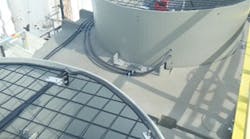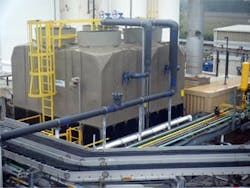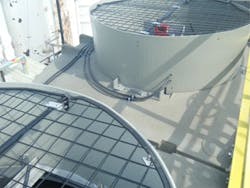Hello, plastic cooling towers. Goodbye, maintenance costs.
Like other chemical manufacturers, Kuehne Chemical (www.kuehnecompany.com) in South Kearny, New Jersey, knows that chemical reactions, particularly reactions between harsh chemicals, need to be controlled.
One of the prime enemies of controlling a chemical reaction is excessive heat generated by the reaction itself, which can make a process unstable and corrupt the outcome. This not only causes product quality problems, but can also introduce elevated hazardous conditions.
Kuehne is a privately held chemical manufacturer with a core competency of manufacturing concentrated solutions of bleach (sodium hypochlorite), which is shipped to customers who may dilute it to desired strengths for varied applications such as water and wastewater treatment, paper processing, and cleaning/disinfection products. Kuehne is also a re-packager and distributor of semi-bulk chlorine, caustic soda, and caustic potash — chemicals that are used in the bleach-production process.
Making bleach involves the manufacturing of a concentrated ultra-pure brine solution. Then, through electrolysis, a chlorine molecule is split away from the brine. The resulting gaseous chlorine is quickly reacted with sodium hydroxide, and the resulting fused product is bleach.
Cooled fusion
Figure 1. Kuehne had to control the heat of reaction in the bleach-making process. Plastic cooling towers help to ensure that reactions between harsh chemicals are controlled.
It appears to be a fairly simple process, but the heat of the reaction must be controlled in the bleach-making process (Figure 1). The process is cooled to the appropriate temperature range partly by heat exchangers that utilize cooling water as the exchange medium. That water, in turn, circulates through a cooling tower where the heat of the chemical reaction is dissipated into the atmosphere. The cooled water then recirculates via pipe lines from the tower back to the heat exchangers, which continuously draw off heat from the combined chemical reactions.
Until recently, some of the most vulnerable components of the heat reaction control process were the cooling towers, which required frequent maintenance, including cleaning and fan drive system adjustments. But the most expensive part of the maintenance requirement was that it required cooling tower downtime, a situation that required the bleach process to be down for extended hours.
The cooling towers are a cost-effective alternative to keeping the heat of reactions down; however, they can’t operate the process without the cooling tower system being online. So, cooling tower uptime is definitely a key piece to processing bleach products.
New route
To ensure maximum uptime of operations and the reliable shipment of products to customers, many industrial and commercial companies are changing over from conventional metal-clad cooling towers to the engineered plastic designs with integrated direct-drive fan motors. That is the route Kuehne decided to take.
With an aging metal-clad cooling tower reaching the end of its service life, the company decided to replace that unit and also add to the plant’s cooling capacity (Figure 2).
Figure 2. With an aging metal-clad cooling tower reaching the end of its service life, Kuehne decided to change to a plastic design with direct-drive fan motors.
The bleach manufacturing process is a tough environment. Chlorine-based products tend to heavily corrode metals. A couple of years ago, a search began for some alternative materials to the galvanized-steel type of tower shell. Most modern cooling tower fills — the packing material underneath the shell — are constructed of honeycombed thermoplastic, so a plastic shell also appeared to be a good solution. In researching newer designs, Kuehne found Delta Cooling Towers (www.deltacooling.com), which makes a seamless, high-density molded polyethylene (HDPE) shell. Because it’s corrosion-proof, this type of unit would be great for our application.
The engineered plastic cooling tower was competitive in purchase price, but when Kuehne compared the long-term maintenance cost and care of a galvanized steel model, the numbers were even more convincing.
After reviewing various Delta models, Kuehne decided on a TM Series 2 Cell model, a lightweight and compact, modular design that is available from 1 to 6 Cell configurations (250-2,000 cooling tons). Looking at long-term performance, Kuehne designed a very durable and maintenance-free platform large enough for the 2 Cell, but with the modular expansion capacity for upgrading up to a 6 Cell model.
Goodbye, maintenance costs
Once installed, a fairly simple operation, the engineered plastic cooling towers easily met the firm’s cooling expectations. The biggest surprise came from the comparatively maintenance-free operation of the system. The surface tension for particles in the plastic cooling tower basin is much less than that of steel basins. Even after more than two years since the startup, there’s been no wind-blown particulate buildup and no mud whatsoever in the tower basin. Scheduled blowdowns are done on the tower, which is standard, but, unlike the metal-clad basins, the blowdowns of the new plastic towers completely wash any foreign materials right down the waste pipe. That means no cleaning of the tower basin.
One of the best features of the new cooling tower design is the direct-drive fan system, which is also a maintenance-cost and downtime saver. Instead of having a large shaft-driven or belt-driven fan drive, Kuehne liked the direct-drive unit with the new Delta system. As a result, Kuehne was able to realize a reduction in total hp requirements, as well as maintenance. The old cooling tower had a 75-hp shaft-drive motor system. The new modular setup has four independent 10-hp direct-drive motors. That’s a reduction of 35 hp, which saves on energy costs for the same cooling tonnage.
| Richard L. Wilkes is director of corporate engineering at Kuehne Chemical. Contact him at (973) 589-0700. |
With a direct-drive motor, you have virtually no maintenance costs. There are no belts or gear reducers, internal gearbox, or bearings to take care of, and it is unnecessary to tune up the balance of the fans, as is often required with shaft- or belt-driven motors.
Basically, motor bearings are lubricated as part of the preventive maintenance (PM) program, and the PM on the direct-drive motors can be done while they are running. So, there is negligible maintenance downtime for the tower, and that’s the big payoff. In fact, Kuehne is seeing on-stream times of more than 96%, 365 days a year, which is more than 14% better than the old system. Kuehne also plans to expand its plant’s cooling capacity with a Delta TM Series 2 Cell model in the near future.


